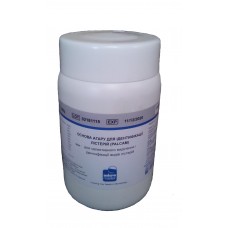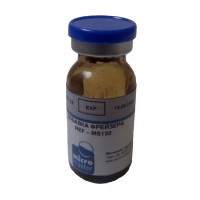Основа бульона Фрейзера
Назначение:
Основа бульона Фрейзера (DM1292) рекомендуется для первичного и вторичного обогащения, выделения и подсчета Listeria monocytogenes в продуктах питания и кормах для животных.
Краткое описание и объяснение:
Листерии - микроаэрофильные, грамположительные, аспорогенные, неинкапсульовани, неразветвленные, регулярные, короткие, подвижные палочки. Подвижность наиболее выражена при 20 ° С. Наиболее распространенные сопутствующие бактерии, которые находят в источниках питания, потенциально содержащие Listeria являются: стрептококки, особенно энтерококки, микрококки, виды Bacillus, Escherichia coli, Pseudomonas aeruginosa и Proteus vulgaris. (1) Листерии растут в диапазоне рН 4.4-9.6, и выживают в продуктах питания с уровнем рН за пределами указанных величин. (2) Определение Listeria основано на успешном выделении организма, биохимических характеристиках и серологическом подтверждении.
Среди листерий только Listeria monocytogenes известна как патоген, вызывающий инфекционные заболевания человека. В 1926 Murray, Webb и Swann (3) впервые описали, что Listeria monocytogenes является широко распространенной проблемой в области общественного здравоохранения и пищевой промышленности. Этот организм может вызвать заболевания людей, такие как менингит, энцефалит и септицемию; тропизм Listeria monocytogenes в ЦНС приводит к тяжелым болезням, часто с высокой летальностью или неврологическими расстройствами в качестве осложнений после перенесенного заболевания (4) особенно у ослабленных лиц и беременных женщин. (5) О первом пищевой вспышка листериоза сообщалось в 1985 году . (6) С тех пор микробиологические и эпидемиологических данные о спорадических и эпидемические случаи листериоза свидетельствуют о том, что основной путь передачи листериоза - через потребление пищевых продуктов, контаминированных Listeria monocytogenes. (7) К продуктам, которые могут служить источниками заражения, включают мексиканский сыр, салат из капусты, индюшачьи сосиски, пастеризованное молоко и маринованный свиной язык. (8) Listeria monocytogenes выделяли из продуктов молочной и других отраслей пищевой промышленности; кроме того Listeria monocytogenes широкорозповсюджена в природе, присутствует во многих необработанных продуктах, в почве, сточных водах, силосе и речной воде. (9)
Основа бульона Фрейзера основана на формуле Fraser и Sperber (10) и используется для обнаружения листерий в пищевых продуктах. Основа бульона Фрейзера разработана так, чтобы обеспечить оптимальные условия для роста Listeria из продуктов питания и проб из окружающей среды.
Принцип действия:
Основа бульона Фрейзера содержит пептический перевар животной ткани, гидролизат казеина, дрожжевой экстракт и мясной экстракт, делают среду высокопитательным, предоставляя азот, углерод и другие питательные вещества, необходимые для роста организмов. Фосфаты обеспечивают буферные свойства среды. Все виды листерий демонстрируют бета-глюкозидазну активность, доказывается почернением среды. Листерии гидролизуют эскулин к глюкозе и эскулетин. Последний в сочетании с ионами трехвалентного железа с трехвалентного цитрата аммония (MS130) образует 6-7 дигидроксикумарин, черно-коричневый комплекс. Аммонийный цитирует железа также усиливает рост L. monocytogenes. Высокая солетолерантнисть листерий (до хлорида натрия) используется для ингибирования роста энтерококков. Хлорид лития также используется для подавления энтерококков, которые также обладают способностью гидролизовать эскулин. Рост сопутствующих бактерий в значительной степени подавляется добавлением налидиксовой кислоты и гидрохлорида акрифлавина (MS131I).
|
Інгредієнти |
Грам/літр |
|
Пептичний перевар тваринної тканини |
5,00 |
|
Ферментативний гідролізат казеїну |
5,00 |
|
Дріжджовий екстракт |
5,00 |
|
М'ясний екстракт |
5,00 |
|
Хлорид натрію |
20,00 |
|
Натрію
гідрофосфат
(х2Н2О) |
12,00 |
|
Калію дигідрофосфат |
1,35 |
|
Ескулін |
1,00 |
|
Хлорид літію |
3,00 |
|
Вирішальне значення рН (при
25°С) 7,2 ± 0,2 |
|
|
Формула може змінюватися і/або доповнюватися у
відповідності до технічних вимог. |
|
Приготовление:
1. Розчиниты 54,92 г среды в 1000 мл дистиллированной воды.
2. Подогреть, если необходимо, до полного растворения среды.
3. автоклавировать 15 мин. при 121оС 1,1 атм.
4. Охладить до 45-50оС и асептически добавить регидратированных содержимое 1 флакона селективной добавки Фрейзера (MS131I) и двух флаконов добавки Фрейзера (MS130) до 1000 мл среды для предварительного обогащения, или по одному флакону каждой добавки до 500 мл среды для вторичного обогащения.
5. Тщательно перемешать и разлить, как нужно.
Процедура тестирования:
1. Исследуемый образец инокулируют в среду первичного обогащения.
2. После инкубации при 30 ° С в течение 18-24 часов, 0,1 мл инокулируют в основу бульона Фрейзера (M1292).
3. После инкубации при 35-37 ° С в течение 24-48 часов проводят пересел на основание оксфордского среды для листерий (DM1078) или основу агара для идентификации листерий (PALCAM) (DM932).
Результаты
Обратиться к соответствующей литературе для получения подробной информации по интерпретации результатов.
Упаковка: пластиковая банка 500 гр
Основа бульона Фрейзера, 500 гр
- Производители Micromaster, Индия
- Модель: 500 гр
- Наличие: 2-3 дня
-
3000.00 грн
Рекомендуемые товары
Селективная добавка Фрейзера (MS131I)
Селективная добавка Фрейзера (MS131I)Назначение: для селективного выделения Listeria monocytogenes и..
270.00 грн





